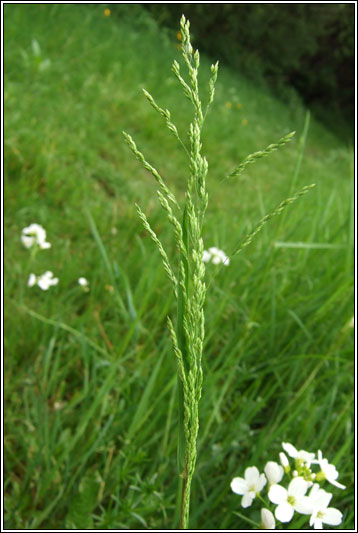
 Rough meadow-grass
Rough meadow-grass
Name: Rough meadow-grass( rough-stalked meadow-grass, roughstalk bluegrass )
Latin name: Poa trivialis L.
Occurrence: Rough meadow-grass occurs as both an annual and perennial grass with procumbent tillers some of which become leafy stolons. It is an indigenous grassland species that has become increasingly important as a weed of winter cereals and herbage seed crops. It is found throughout the UK in all types of grassland especially newly established leys. It is native in open woods, marshes, ditches, damp grassland, rough and cultivated ground. The species is found in the hedge bottom and field margins as well as spreading into arable fields. It is common on moist and even on wet soils. In surveys around 1912, rough meadow-grass was found mainly on clay, loam and chalk but only occasionally on sandy soil.
In 1975 it was said that 20% of arable crops in the UK were infested with rough meadow-grass. In a survey of weeds in conventional cereals in central southern England in 1982, rough meadow-grass was found in 29% of winter wheat, 14% of winter barley and 7% of spring barley. In winter oilseed rape in 1985, it was found in only 3% of crops. In a study of seedbanks in arable soils in the English midlands sampled in 1972-1973, rough meadow-grass was recorded in 19% of the fields sampled in Oxfordshire and 38% of those in Warwickshire but never in large numbers. Seed was found in 1.5% of arable soils in a seedbank survey in Scotland in 1972-1978. It was the second most abundant grass weed in a seedbank survey in swede-turnip fields in Scotland in 1982, being found in 85% of fields sampled.
Rough meadow-grass is often a colonist following sward deterioration in cultivated grassland. It is palatable to stock and was an important constituent of permanent grassland but is now little sown.
Biology: Rough meadow-grass flowers in June and is wind pollinated. Plants require a period of winter cold in order to flower. Rough meadow grass can produce 200 to 1,700 seeds per flower head and 29,000 seeds per plant. In a cereal crop, rough meadow-grass may produce 1,000 to 14,000 seeds per plant. Seeds are shed between June and August. Innate dormancy is short but dormancy can be enforced by seed burial. Proximal seeds are less dormant and germinate more readily than distal seeds.
Seeds require light for germination which ensures that only seed at or near the soil surface will germinate and establish. Germination on the soil surface is largely confined to the autumn after shedding. Wetting and drying of the seed enhances germination. However, germination is reduced when seeds are at a high density in the soil. Seed from grassland populations is less dormant than seed from arable situations. In grassland, peak emergence is in September. In cultivated soil, seedling emergence occurs from March to October but is affected by the depth of burial and timing of cultivations. The optimum depth of emergence is 0-10 mm and the maximum is 30 mm.
Rough meadow-grass seedlings that emerge in the autumn become vernalised over the winter in preparation for flowering the following year. Plants remain winter green but there is little growth before April. Spring emerging seedlings are unlikely to become vernalised and will therefore not flower in the current year. Rough meadow grass is cold tolerant and remains winter green but makes little growth until April.
Persistence and Spread: Rough meadow-grass has relatively persistent seeds for a grass. It has been suggested that based on seed characters it should persist longer than 5 years in soil. Seeds have been recorded in large numbers in the soil beneath pastures even when the plant was poorly represented in the vegetation.
Reproduction by seed is very important but rough meadow-grass also has long creeping stolons that ensure vegetative spread.
Rough meadow-grass seed has occurred as a contaminant of cereal seed. Proximal seeds tend to clump together at and after dispersal due to threads at the base of the seeds. It is difficult to separate them out when they contaminate herbage seeds. The seeds are ingested by earthworms and viable seeds have been recovered in wormcast soil. Seed germination increased from 66 to 90% following passage through an earthworm.
Management: Seedlings have fibrous roots and are easily dislodged by harrowing and other cultivations. Studies have shown that cutting seedlings at the soil surface is more effective than partial burial. Complete burial, alone and after uprooting seedlings, is the most consistently effective treatment. There is the potential for recovery if seedlings are left on the soil surface or if just the roots are buried. Shoot fragments can regenerate after cultivation. Shading from the crop canopy improves the level of control.
After crop harvest, ploughing buries the freshly shed seeds but this may lead to a future weed problem. Delaying stubble cultivations allows seeds a period to germinate on the soil surface and reduces the number of viable seeds that may persist after burial.
Winter cropping favours Poa species, as does increasing the water holding capacity of soil by straw incorporation. Rough meadow-grass seedlings that emerge in spring barley do not become vernalised and will not flower and set seed. Spring barley can therefore be used as a cleaning crop provided the rough meadow-grass plants are destroyed after harvest. A sown boundary strip around the margin of an arable field will delay but not prevent the spread of rough meadow-grass in to the field.
In permanent grassland, rough meadow-grass is favoured by increased soil fertility. Both percentage cover and seed numbers in the soil increase. It does not persist under close mowing
Rough meadow-grass seeds are consumed by ground beetles. and is susceptible to trampling. However, rough meadow-grass will invade permanent grassland and become established under severe grazing.
No comments:
Post a Comment